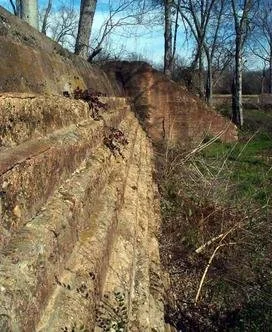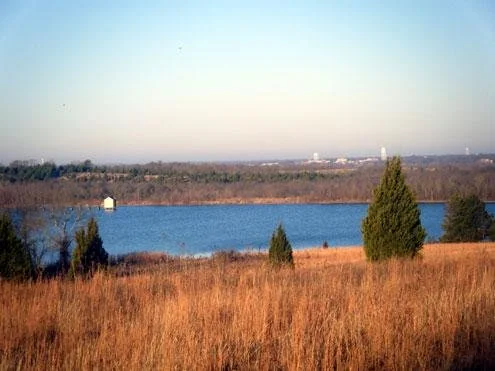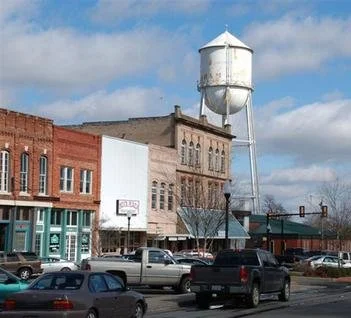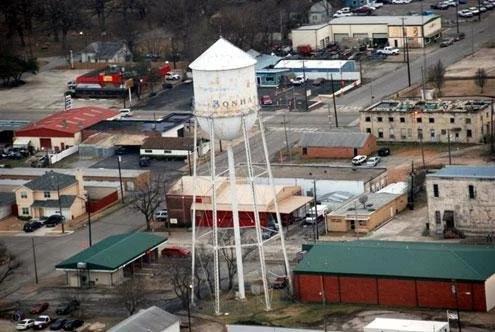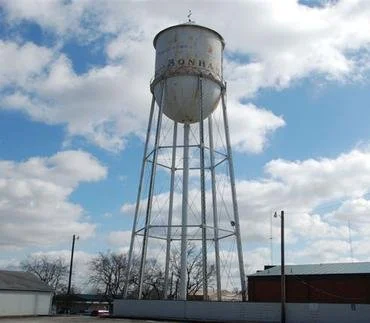The Water Tower Built by Texas and Pacific Railroad
By Tim Davis. Reprinted from North Texas e-News, February 24, 2010
From the moment Texas & Pacific Railroad first laid tracks in Fannin County in the early 1870s, there was perhaps a suspicion that water, an absolute necessity for keeping steam locomotives rolling, would be scarce. The February 2, 1887 Dallas News reported that there had “been, for some time, a scarcity of water at the divisional station of the Transcontinental Railway, Bonham . . . and it is now necessary to keep two water trains running into that point in order to keep a large enough supply on hand.”
Echoing the same sentiments, the News of October 24, 1891 reported: “The scarcity of water in Bonham is getting to be a very serious question. The oil mill has been compelled to shut down on account of the drying up of the railroad pool, and unless it rains soon other manufacturing institutions will have to follow suit.” (The “railroad pool” was built by Texas & Pacific for a water supply. It was located just south of the tracks about a half mile west of the Main Street intersection, just west of where the cotton mill once stood. It was created by damming up Powder Creek. The dam wall is easily seen by anyone walking the excellent track at the new Powder Creek Park.) (photo below by Allen Rich)
In the early 1890s city officials began addressing the water shortage. Frustrated at failed attempts to drill productive wells, in 1893 they decided to build an artificial lake east of town. The May 28, 1893 Dallas News reported that work on the lake was to begin soon. By the mid 1890s the lake and an accompanying standpipe were serving the City of Bonham.
Even so, Texas & Pacific continued to rely largely on its pool in town. Over the years it proved a frustrating and unreliable source of water. As in previous decades, water trains were needed. In the early 1900s such trains were taking on water at Lake Gordon, just west of Paris, according to the Dallas Morning News of February 13, 1911.
By the early 1920s Texas & Pacific had expanded its roundhouse in Bonham and installed a larger turntable as well. This was done to accommodate the larger steam locomotives in use at the time. Bigger engines and longer trains meant the need for more water, and by the late 1920s it was clear that a new source had to be found.
By mid 1928, T & P officials began exploring the option of using water from the city lake. It wouldn’t necessarily hurt the city’s water supply since good wells had been successfully drilled in town. However, the plan might affect water pressure, and that potential problem could not be ignored. (Old Bonham City Lake photo below by Tim Davis)
The possibility of T & P getting water from the city lake was first discussed by the Bonham City Council at its October 2, 1928 meeting. It was only a brief discussion with no action taken.
At its November 20th meeting the council met with a T & P official to discuss the matter further. The council stated that it initially liked the idea, but wanted T & P officials to get an opinion on the proposal from the Insurance Commission in Austin.
Once the Insurance Commission gave the plan its approval, T & P officials went before the city council again on January 18, 1929 with more details. This time they sweetened the deal by offering to build a 300,000 gallon elevated steel water tower in the city near the business district. (It is unclear whether the tower was T & P’s idea or a recommendation from the Insurance Commission.) Minutes of the meeting noted that the council was unanimously pleased with the proposal.
At its October 5, 1929 meeting the Bonham City Council entered into a formal agreement which allowed Texas & Pacific Railroad to raise the dam wall of the city lake by five feet, and allowed it to begin using water from the lake and its standpipe reservoir for its rail-yard operations. In return, T & P agreed to build a 300,000 gallon water tower on the lot behind city hall (now behind Legend Bank). (photo below of view of downtown Bonham water tower from Hwy east of town by Mike Weber)
The Dallas Morning News of May 22, 1930 noted that work on the new water tower began just a few days earlier. And perhaps not a minute too soon, for the News of September 17, 1929 had reported that the old T & P pool was “filled with mud and more than likely [would] be done away with entirely.”
The tower was perhaps finished by July 1930. In its meeting held on the 14th of that month, the Bonham City Council decided that a light and weather vain should be placed on top of it.
Along the same line, in its August 29 meeting it approved the expenditure of $25 to paint a sign for the tower. (photos below of downtown Bonham water tower by Mike Weber)
The possibility of T & P getting water from the city lake was first discussed by the Bonham City Council at its October 2, 1928 meeting. It was only a brief discussion with no action taken.
At its November 20th meeting the council met with a T & P official to discuss the matter further. The council stated that it initially liked the idea, but wanted T & P officials to get an opinion on the proposal from the Insurance Commission in Austin.
Once the Insurance Commission gave the plan its approval, T & P officials went before the city council again on January 18, 1929 with more details. This time they sweetened the deal by offering to build a 300,000 gallon elevated steel water tower in the city near the business district. (It is unclear whether the tower was T & P’s idea or a recommendation from the Insurance Commission.) Minutes of the meeting noted that the council was unanimously pleased with the proposal.
At its October 5, 1929 meeting the Bonham City Council entered into a formal agreement which allowed Texas & Pacific Railroad to raise the dam wall of the city lake by five feet, and allowed it to begin using water from the lake and its standpipe reservoir for its rail-yard operations. In return, T & P agreed to build a 300,000 gallon water tower on the lot behind city hall (now behind Legend Bank). (photo below of view of downtown Bonham water tower from Hwy east of town by Mike Weber)
It seems safe to assume that the new structure was definitely in use by late 1930. Reporting on developments in Bonham, the October 27 Dallas Morning News noted: “The deep wells downtown and the new pumps send the water into the new tank back of city hall with a terrific pressure.”
Now, Bonham’s first major water tower must come down for practical reasons.
How to put its eighty years of service into perspective? Well, think of it this way: When the tower first graced the Bonham skyline Herbert Hoover was still President of the United States; Sam Rayburn was still a relative unknown member of Congress; few people had heard of Franklin D. Roosevelt; a gallon of gas was ten cents; a hamburger could be had for a nickel. And the Great Depression, that major turning point in U.S. history, was still in its infancy.
